I am interesting in knowing the phase shift between two sine-waves type. For that I am trying to fit each wave with scipy.cuve_fit. I have been following this post. However I obtain negative amplitudes and the phase shift looks like forwarded pi radians sometimes.
The code that I am using is that one below:
def fit_sin_LD(t_LD, y_LD):
'''Fit sin to the input time sequence, and return fitting parameters "amp", "omega", "phase", "offset", "freq", "period" and "fitfunc"'''
ff = np.fft.fftfreq(len(t_LD), (t_LD[1]-t_LD[0])) # assume uniform spacing
Fyy = abs(np.fft.fft(y_LD))
guess_freq = abs(ff[np.argmax(Fyy[1:])+1]) # excluding the zero frequency "peak", which is related to offset
guess_amp = np.std(y_LD) * 2.**0.5
guess_offset = np.mean(y_LD)
guess = np.array([guess_amp, 2.*np.pi*guess_freq, 0., guess_offset])
def sinfunc_LD(t_LD, A, w, p, c):
return A * np.sin(w*t_LD + p) + c
#boundary=([0,-np.inf,-np.pi, 1.5],[0.8, +np.inf, np.pi, 2.5])
popt, pcov = scipy.optimize.curve_fit(sinfunc_LD, t_LD, y_LD, p0=guess, maxfev=3000) # with maxfev= number I can increase the number of iterations
A, w, p, c = popt
f = w/(2.*np.pi)
fitfunc_LD = lambda t_LD: A*np.sin(w*t_LD + p) + c
fitted_LD = fitfunc_LD(t_LD)
dic_LD = {"amp_LD": A, "omega_LD": w, "phase_LD": p, "offset_LD": c, "freq_LD": f, "period_LD": 1./f, "fitfunc_LD": fitted_LD, "maxcov_LD": np.max(pcov), "rawres_LD": (guess, popt, pcov)}
return dic_LD
def fit_sin_APD(t_APD, y_APD):
''' Fit sin to the input time sequence, and return fitting parameters "amp", "omega", "phase", "offset", "freq", "period" and "fitfunc" '''
ff = np.fft.fftfreq(len(t_APD), (t_APD[1]-t_APD[0])) # assume uniform spacing
Fyy = abs(np.fft.fft(y_APD))
guess_freq = abs(ff[np.argmax(Fyy[1:])+1]) # excluding the zero frequency "peak", which is related to offset
guess_amp = np.std(y_APD) * 2.**0.5
guess_offset = np.mean(y_APD)
guess = np.array([guess_amp, 2.*np.pi*guess_freq, 0., guess_offset])
def sinfunc_APD(t_APD, A, w, p, c):
return A * np.sin(w*t_APD + p) + c
#boundary=([0,0,-np.pi, 0.0],[np.inf, np.inf, np.pi, 0.7])
popt, pcov = scipy.optimize.curve_fit(sinfunc_APD, t_APD, y_APD, p0=guess, maxfev=5000) # with maxfev= number I can increase the number of iterations
A, w, p, c = popt
f = w/(2.*np.pi)
fitfunc_APD = lambda t_APD: A*np.sin(w*t_APD + p) + c
fitted_APD = fitfunc_APD(t_APD)
dic_APD = {"amp_APD": A, "omega_APD": w, "phase_APD": p, "offset_APD": c, "freq_APD": f, "period_APD": 1./f, "fitfunc_APD": fitted_APD, "maxcov_APD": np.max(pcov), "rawres_APD": (guess, popt, pcov)}
return dic_APD
I dont understand why curve_fit is returning a negative amplitude (that in terms of physics has not sense). I have tried as well setting boundary conditions as **kwargs* with:
bounds=([0.0, -np.inf,-np.pi, 0.0],[+np.inf, +np.inf,-np.pi, +np.inf])
but it yields a more weird result.
I added an image showing this difference:
Does anyone how to overcome this issue with phases and amplitudes?
Thanks in advance

